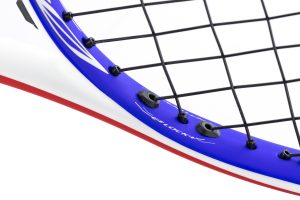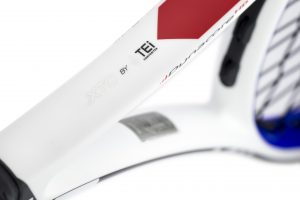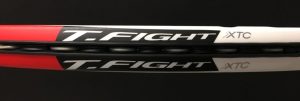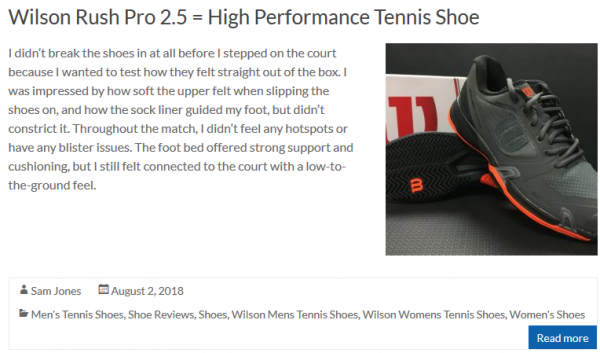It’s hard to imagine, but Tecnifibre’s T-Fight line has been around for a decade now. This year, the line features brand new styling courtesy of Tecnifibre’s new partner: Lacoste. The updated series looks stellar and sophisticated with its French flag color pallet, while innovative Xtreme Touch Construction (XTC), a mix of graphite, alloy, and polyester fibers, increases frame stability, yet allows better flexibility and ball feel. Tour players Jeremy Chardy, Daniil Medvedev, and Aljaz Bedene upgraded to the new T-Fight XTC 305 this summer, and are racking up the wins.
Tecnifibre XTC T-Fight 305
- Comfortable response; easy on the arm
- 18 x 19 string pattern is just as dense as many 18 x 20 patterns; excellent control
- Lighter overall weight which is easy to customize
- One of the best looking racquets for 2018
 What’s New?
What’s New?
- Lacoste Partnership means streamlined paint job and gorgeous finish
- An updated Armor Cap head guard which is 40% more durable without increasing weight
- Streamlined shaft construction with a slightly different shape, but no beam width change
- Updated EZ lock+ eyelets for ease of stringing and grommet durability
Playtesting XTC
Groundstrokes
Though the 320 is heavier than the 305, the 305 offers surprising heft for its weight. Some of this is due to the fairly high swing weight in the 320s. The lighter overall weight offers best-in-class mobility.It’s easy to whip around from both offensive and defensive positions. I must say the 18 x 19 string pattern will suit itself best to players who strike the ball fairly flat.In order to produce topspin, players will have to focus on getting the racquet face below the ball and brushing up. The frame is exceedingly enjoyable when taking the ball on the rise. I caught myself over swinging at first, but then settled in and let the racquet’s mass do the heavy lifting. Think of a middleweight boxer who punches like a heavyweight, and you’ll get an idea of what the 305 is like in action.

Serves & Returns
Control was the predominant theme when serving with the 305. While you don’t get a ton of free power, the lighter weight lets you go after the ball again and again without any arm fatigue. The string pattern really opens up when using a thinner gauge polyester like Black Code 18G, and it helps produce easier access to spin even with the relatively dense string pattern. The thinner gauge will also reduce the swing weight a bit so you get more bite, and can move the racquet a little easier through the air. The XTC technology (3, 9, and 12 O’Clock positions) helps the stability and feel in the upper-hoop substantially on flatter first serves. Additionally, the sweet spot seems to sit a little bit higher than on a standard frame. Ultimately, so much of serving comes down to technique, and while the 305 won’t fix any technical flaws, the racquet is a friend to tender arm and shoulder joints (provided string tension is sensible).
 Volleys
Volleys
When attacking short balls and moving forward, I was supremely confident in the stability of the 305. At times, flexibility and feel can come at the expense of stability, but the characteristics coincide brilliantly within the 305. It’s easy to keep the racquet head up and in optimum volleying position when knocking off easy punch volleys, and the directional control is good to great. Players that really like to carve their volleys with a bit more underspin might struggle to get the bite they want, but the ball will still remain on target.
Overall
For my money, the XTC T-Fight 305 is one of the best looking racquets out there. With its light overall weight, but muscular stability, I didn’t want the playtest to end. The 305’s 18 x 19 string pattern and thinner beam play like a slightly more user-friendly Head Prestige MP. Heavy spin players may need to experiment with a few string combinations and tensions, or even have a look at the T-Fight 315 or 300. Take a note from the touring pros: They’re using the T-Fight 305 as a platform, and then adding some weight and modifying it from there. I am a racquet tinkerer of the highest order and could spend hours customizing the 305 to my “Excalibur.”
Playtest Info
The XTC T-Fight 305 was strung with HDX Tour at 54 pounds. Because of its dense pattern, I would drop the tension to 50-52 pounds, and I think Black Code or Razor Code 18g would be a great fit.
Play Tester: Sam Jones
 Height: 5′ 11″
Height: 5′ 11″Weight: 192 lbs
Check out these other blog posts:






